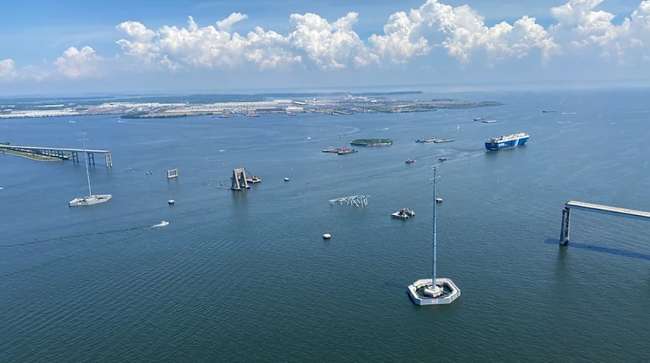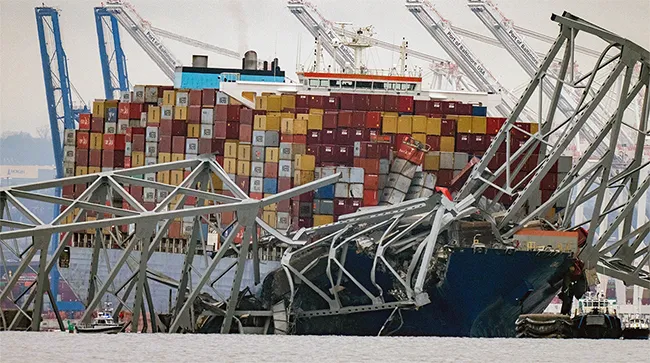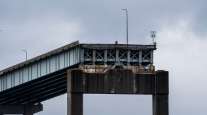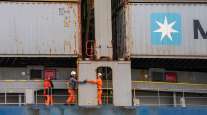Baltimore Sun
Key Bridge Insurer Pays Maryland Agency $350 Million

[Stay on top of transportation news: Get TTNews in your inbox.]
Whether the replacement Francis Scott Key Bridge will be fully federally funded — or if the state of Maryland will need to chip in 10% of it — remains to be seen, but one sizable payment that will cover a portion of the rebuild has already landed. The Maryland Transportation Authority received a $350 million insurance payout this month from Chubb, the Key Bridge’s insurer.
The transportation authority, which owns the bridge, said the money will go toward funding the completed cleanup, as well as rebuilding the new span, projected to open to traffic in October 2028 and cost roughly $1.7 billion.
The bulk of those insurance funds are expected to ultimately go to the federal government, but the transportation authority and the Federal Highway Administration did not provide details as to when that money might change hands.
“FHWA is coordinating with Maryland to determine a course of action that follows federal regulations for the recovery of damages or insurance proceeds but also affords Maryland maximum flexibility and efficiency to begin the reconstruction of this critical structure,” the FHWA said in a statement to The Baltimore Sun.

The containership Dali rests against wreckage of the Francis Scott Key Bridge in the Patapsco River on March 27. (Alex Brandon/Associated Press)
The policy — a “property and business interruption policy,” per the authority — is the only one held by the transportation authority related to the Key Bridge, which was knocked down by a containership that had lost power on March 26. The disaster killed six construction workers, tumbled 50,000 tons of debris into the Patapsco River and temporarily stalled shipping commerce into the Port of Baltimore.
In the immediate aftermath, Democratic President Joe Biden pledged that the federal government would pay for 100% of the new bridge — which the federal government has done in other disaster situations — but that has not yet been coded into law. When a federal highway is built, as will be the case when the bridge carrying Interstate 695 is constructed, the default is for the federal government to pay 90%; if that’s the case, it would leave Maryland to pay the remaining 10%, approximately $170 million.
Sen. Ben Cardin (D-Md.) said earlier this month: “We’re on our way to get that legislation passed,” in regard to the federal government fully funding the bridge.
Team Maryland has always understood the importance of the @USACEHQ’s deep expertise in executing complex projects, but after the collapse of the FSK Bridge this March, the whole world witnessed their professionalism first hand.
Proud to get this done.https://t.co/kip57Yfxmk — Senator Ben Cardin (@SenatorCardin) August 2, 2024
Whether the federal government fully funds the new bridge could impact how much state tolls are increased in the coming years, the transportation authority said.
Before the bridge collapse, the transportation authority had forecast a toll increase during fiscal 2029 (which begins July 1, 2028) “due to factors such as inflation,” the authority said in a statement last month. But the authority has predicted a $143.9 million revenue loss over the next five years, because of lost Key Bridge tolls, which might prompt higher fees on other Maryland toll facilities, such as bridges and tunnels. Minutes from a June transportation authority meeting indicate that a toll increase would be “systemwide.”
Want more news? Listen to today's daily briefing above or go here for more info
“With the collapse of the bridge, the timing for the increase has been accelerated by one year,” the authority said in a statement. “Congressional decisions could impact the size of the increase.”
The next Key Bridge is officially deemed a “replacement bridge,” which enabled it to more quickly receive federal environmental approval. It will be longer, have a higher vertical clearance — at least 230 feet — and wider shoulders, in accordance with updated highway laws, but will be built on the same center line as the old span and also be four lanes wide.
The transportation authority is expected to soon select the contracted builder of the span and is accepting proposals for an engineering consultant, which will act as the authority’s engineering representative and will manage the builder. A third request for proposals will eventually identify a construction management firm.
Distributed by Tribune Content Agency, LLC




